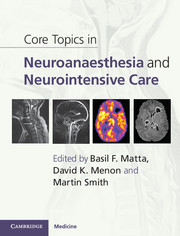Book contents
- Core Topics in Neuroanaesthesia and Neurointensive Care
- Core Topics in Neuroanaesthesia and Neurointensive Care
- Copyright page
- Contents
- Contributors
- Preface
- Acknowledgements
- Section 1 Applied clinical physiology and pharmacology
- Section 2 Monitoring and imaging
- Section 3 Neuroanaesthesia
- 11 General considerations in neuroanaesthesia
- 12 Anaesthesia for supratentorial surgery
- 13 Anaesthesia for intracranial vascular surgery and carotid disease
- 14 Principles of paediatric neurosurgery
- 15 Anaesthesia for spinal surgery
- 16 Anaesthetic management of posterior fossa surgery
- 17 Anaesthesia for neurosurgery without craniotomy
- Section 4 Neurointensive care
- Index
- Plates - PDF Only
15 - Anaesthesia for spinal surgery
from Section 3 - Neuroanaesthesia
Published online by Cambridge University Press: 05 December 2011
- Core Topics in Neuroanaesthesia and Neurointensive Care
- Core Topics in Neuroanaesthesia and Neurointensive Care
- Copyright page
- Contents
- Contributors
- Preface
- Acknowledgements
- Section 1 Applied clinical physiology and pharmacology
- Section 2 Monitoring and imaging
- Section 3 Neuroanaesthesia
- 11 General considerations in neuroanaesthesia
- 12 Anaesthesia for supratentorial surgery
- 13 Anaesthesia for intracranial vascular surgery and carotid disease
- 14 Principles of paediatric neurosurgery
- 15 Anaesthesia for spinal surgery
- 16 Anaesthetic management of posterior fossa surgery
- 17 Anaesthesia for neurosurgery without craniotomy
- Section 4 Neurointensive care
- Index
- Plates - PDF Only
Summary
Keywords
- Type
- Chapter
- Information
- Core Topics in Neuroanaesthesia and Neurointensive Care , pp. 222 - 236Publisher: Cambridge University PressPrint publication year: 2011



